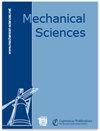一种新型轮腿变形机构的障碍性能和倾翻稳定性研究
IF 1.5
4区 工程技术
Q4 ENGINEERING, MECHANICAL
引用次数: 0
摘要
摘要设计了一种基于电磁离合器和齿轮齿条传动的新型轮腿变形机构。该机构结构紧凑,操作简单,可在车轮上滚动,并可借助支腿越过障碍物。首先,建立行走模型,研究机构的运动学特性;支撑腿的交替不影响顺利过障,但会引起主体质心角速度的阶跃变化。其次,分析了采用支腿的翻越模式和越障模式的越障性能。对于翻车方式,最大爬升高度为87.36 mm。对于使用支撑腿的过障模式,最大攀爬高度为支撑腿的最大延伸长度。根据爬升高度,得到了不同爬升方式的切换准则。此外,主体的滚动角度对支撑力和驱动力矩的影响较大,而腿与地面的接触角的影响较小。最后,采用稳定锥法对轮腿变形机构的倾翻稳定性和抗干扰能力进行了评价。本文章由计算机程序翻译,如有差异,请以英文原文为准。
Research on obstacle performance and tipping stability of a novel wheel–leg deformation mechanism
Abstract. A new type of wheel–leg deformation mechanism, based on an
electromagnetic clutch and gear rack transmission mechanism, is designed.
This mechanism has a compact structure and simple operation, which can roll on wheels and surmount obstacles with a support leg. Firstly, the walking model is established to study the kinematics characteristics of the mechanism. The
alternation of the support legs does not affect smooth obstacle crossing,
but will cause the step change of the angular velocity of the centroid of
the main body. Secondly, the obstacle-surmounting performance of roll-over
mode and obstacle-crossing mode using support legs is analyzed. For roll-over mode, the maximum climbing height is 87.36 mm. For obstacle-crossing
mode using support legs, the maximum climbing height is the maximum
extension length of the support leg. According to the climbing height, the
switching criteria of different climbing modes are obtained. In addition,
the rolling angle of the main body has a greater impact on the support force and driving torque, while the contact angle between the legs and the ground has a small impact. Finally, the tipping stability and anti-interference ability of the wheel–leg deformation mechanism is evaluated using the stability cone method.
求助全文
通过发布文献求助,成功后即可免费获取论文全文。
去求助
来源期刊

Mechanical Sciences
ENGINEERING, MECHANICAL-
CiteScore
2.20
自引率
7.10%
发文量
74
审稿时长
29 weeks
期刊介绍:
The journal Mechanical Sciences (MS) is an international forum for the dissemination of original contributions in the field of theoretical and applied mechanics. Its main ambition is to provide a platform for young researchers to build up a portfolio of high-quality peer-reviewed journal articles. To this end we employ an open-access publication model with moderate page charges, aiming for fast publication and great citation opportunities. A large board of reputable editors makes this possible. The journal will also publish special issues dealing with the current state of the art and future research directions in mechanical sciences. While in-depth research articles are preferred, review articles and short communications will also be considered. We intend and believe to provide a means of publication which complements established journals in the field.
 求助内容:
求助内容: 应助结果提醒方式:
应助结果提醒方式:


